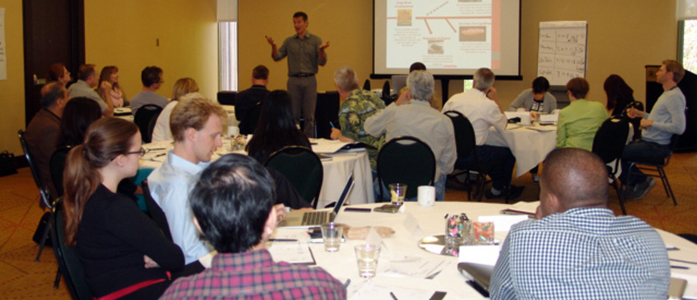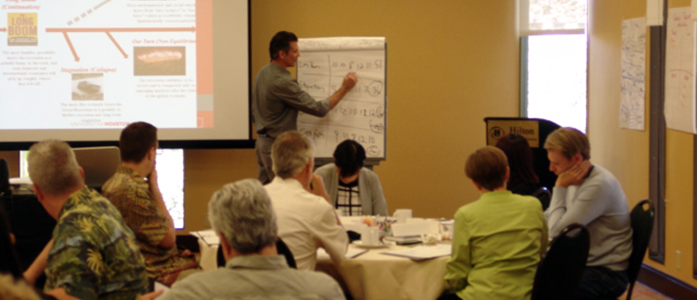When I wooed the American Council of Learned Societies last year, proposing they assign CFM one of their public fellows, I promised that the Alliance would provide futurist training for the humanities post-doc that also matched our needs. Holding up our end of the bargain, we sent Dr. Nicole Ivy off to Texas last month to take the University of Houston’s Foresight certificate program. I myself took this 5-day, immersive workshop back in 2009 to help jump start my plans for CFM. Other museum alumni of the U. Houston certificate short course include Joe Cavanaugh, director of the National Museum of the Pacific War and Lisa Eriksen (who went on to organize the California Association of Museums’ Future Leaders program). Kate Burgess-Mac Intosh, principle of Revitalizing Historic Sites, enrolled in regular classes at the University of Houston to earn their graduate certificate in Foresight. Today on the Blog Nicole debriefs us on her time in Houston. I hope you will consider taking the course as well, and join our small but growing band of museum futurists!
Two weeks ago, I had the pleasure of attending the University of Houston Foresight Certificate Course in order to learn more about the strategies of futures work. I was part of a cohort of thirty professionals from a wide range of industries and international locations who descended on Houston, Texas for a week-long, intensive study of foresight. Led by experienced futurists and field leaders Peter Bishop and Andy Hines, the course immerses students in the theory grounding futures studies before moving them through a series of in-depth group exercises designed to teach facilitation skills as well as core concepts. This project-based approach gives participants an opportunity to have hands-on experience with the kind of work that professional futurists do within organizations and groups: framing issues and scanning for multiple forms of change; building scenarios; analyzing alternative outcomes; and conducting goal-based planning.
Foresight analysis has expanded out from its use in government and in a core group of specific industries (oil and technology, for instance) into the public and private sectors more broadly. As people and industries search for ways to adapt to the rapid pace of change in today’s world, the work of visioning probable, possible, and preferred futures is now more important than ever before. The Houston Foresight Course prepares attendees to systematically analyze change across the STEEP categories: the social, technological, economic, ecological, and political trends shaping our world. In addition to emphasizing trend analysis and systems thinking, the course provides invaluable tools for crafting stories that imagine futures that we might not otherwise consider.
 |
| UH Foresight Course in Action |
One of the most distinctive features of this course is its global scope. My fellow attendees represented a staggering variety of industries, from international government, military, and law enforcement to cosmetics and materials science. I practiced mapping the future of consumer behavior with members of the global intelligence community and with librarians. As a person in the museum field who thinks a great deal about the humanities, I was, admittedly, out of my comfort zone. But, that’s part of the strength of the course. Foresight analysis stresses that the ways that people understand how social change happens—whether they view change as constant, cyclical, or driven by crisis, for instance—determines how they imagine the outcomes of change. Witnessing how people from diverse places and fields think about change drove home the importance of foresight analysis as a means of systematically evaluating the assumptions we make about what’s possible.
My biggest takeaways from the course can be summed up in three themes:
-
- The Value of Systems Thinking
-
- The Danger of Un-Challenged Assumptions
-
- The Importance of Alternatives
Systems Thinking
Systems are all around us. We might think of the “butterfly effect,” or how a small change in one’s process can create ripples of change that reach out in many directions. The UH course stressed that the things that we observe to occur might have consequences far greater that we might immediately imagine. Mapping out the possible and also unexpected effects of any given occurrence is an important strategy for thinking beyond the now.
Un-challenged Assumptions
One of the most compelling exercises of the course challenged groups to come up with examples of times when the “common-sense” answer resulted in more problems than it solved (Full disclosure: My response was “standardized testing.”) That activity revealed the danger of the “common-sense” solution in long-range planning. By visioning the future beyond the horizon of what we commonly know, we might come up with truly innovative versions and visions of what we might do.
The Importance of Alternatives
A key principle of strategic foresight is alternative foresight analysis. In this process, individuals and groups identify a baseline for a possible future (for example, wearable technology becoming ubiquitous in health-monitoring accessories) and then identify alternative outcomes that counter or otherwise disrupt this baseline (say, wearables giving way to implantables). The scenario-building work that follows proceeds from the alternative future, rather than the baseline. While this approach seems, at first glance, counter-intuitive, I found it to be one of the most impactful lessons of the course. Some of the best ideas arise when we invert the futures we expect and build out from that perspective.

The Houston foresight course challenged me personally and professionally to move beyond my comfort zone to think more expansively about long-range change. But, it also reminded me of the power of stories. After all, scenario building is, at heart, a way to craft a story of probable futures. I encourage you to check out the course and practice your own foresight chops in the CFM Future Fiction challenge. The use of storytelling as a means of analyzing change is something the museum field is particularly poised to take advantage of—telling stories is what we do.
Elizabeth Merritt












